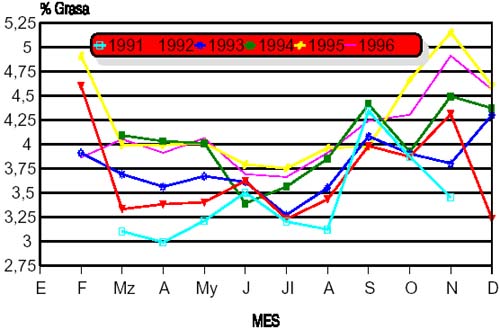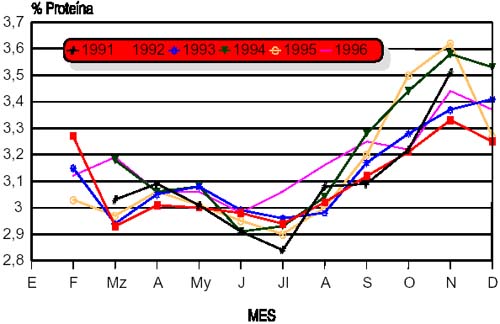Department of Farming Technology at I.E.S. “La Granja”, 39792 Heras, (Cantabria), Spain
ABSTRACT
For six years (1991-1996) we studied the milk production with a gradual increase in the number of grazing heads in a field sown with Lolium perenne (cv. Tove) and Trifolium repens (cv. Grassland Huia). The production of milk per cow and hectare was 5 156 and 12 116 l, respectively. The index of efficiency or milk produced from forage estimated from energy was 90.97 percent, which means 11 274 l/ha; on the contrary, analysing this with respect to the crude protein, the output may be 15 000 l of milk. This imbalance in milk production is caused by a nutritional disproportion in the relationship protein/energy of the fodder. The percentage of milk fat was 3.79 and 3.08 percent for the protein. So we conclude that one of the limiting factors in the production of milk in systems based on grazing with the minimum addition of concentrates, is energy and the excess of degrading protein in rumen.
Keywords: Cantabria, grazing, potential milk
INTRODUCTION
The surface area of Cantabria is 528 856 ha (MAPA, 1993), of which 28.06 percent is grass fields and grazing fields and 3.44 percent is agricultural land. Due to its Atlantic climate, enjoying mild temperatures and frequent rains, it is the right place for milk production. In spite of the milk quota, milk production increased; so, in the 1980s the production per farm was 18 500 l/year, in 1996 and 1997, 62 153 l. Moreover, the production of milk per cow and year was 3 000 l in the 1980s and 7 000 in 1997 (cows which are under control).
On the other hand, forage resources in farms are not used thoroughly, as between 35.5 and 51 percent of annual consumption of dry matter of cows belongs to concentrates and other food, mainly hays and subproducts (Salcedo, 1994).
The aim of this work is to study the productivity of a prairie undergoing gradual increase in grazing capacity and decrease in the supply of concentrate, thus increasing the efficiency of the pasture for the production of milk.
MATERIALS AND METHODS
The experience was carried out at the I.E.S. “La Granja”, Heras, Cantabria (Spain), on an area of 3.58 ha and 8 a. since 1994. The mean fertilization applied in the six-year period mentioned was 234-92-81 uf/ha of N-P-K. The CG (grazing heads in field) increased from 1.67 cows/ha in 1991 to 2.66 in 1996. The births were grouped at the end of winter (mean date 16 February) and, grazing time at the beginning of March. Feeding was based on grass plus 2.5 kg/head/day of concentrates; moreover, in 1996 1.12 kg of DM of maize silage from March to August was added. In periods of low grass growth the cows are fed on grass silage harvested in spring plus 2.5 kg of concentrates.
The milk produced was established as the difference between the energy total (Mcal/head and day) in the diet and that from the concentrate, called the rate of efficiency.
RESULTS AND DISCUSSION
Table 1 shows the production at cow level as well as per hectare in the period studied. The increase of CG was 59.3 percent in six years. This was due, among other reasons, to the increase in the nitrogen, a greater number of grazings per ha and the silage of grass before gleaning, making the most of springtime.
The individual production per cow was 5 258 l of milk, no differences were found during these years, due to the consumption of concentrate (15 124 kg/ha) and the nutritional quality of the grass. The increase in the (CG) means a loss in the production of milk per cow, but an increase in the output per hectare (Ryan, 1989; Mosquera and González, 1993). In our experiment we could see this, especially as from 1992 to 1995, but the increase of 1996 is due to a rainy summer which prolonged the grazing period, and to the complement of maize silage during the spring and part of the summer.
Sánchez and Argamentería (1989) say that on the coastal area of Asturias, 10 000 l/ha and year must be produced, on just forage, with a field occupancy of 2.5 cows/ha. Similar results are obtained in the present experiment with an average occupancy of 2.34 cows/ha/year, coinciding with those mentioned by González et al. (1987) complemented with 677 kg of concentrate per cow and year, though in the present work the quantity of concentrate per cow was 645 kg and larger than those obtained by González (1987) with 450 kg of concentrate and 240 kg of N/ha in a three-year experiment under Galician conditions; this may be due to a lower CG (2.2 cows/ha) than that used in our experiment. This means a rate of efficiency of 90.9 percent, in close relationship with the energy content of grass, as the protein from fields has a high percentage of Lolium Perenne, under our conditions there is 15 000 l from protein and a mere 9 818 for energy.
Table 1. Production of milk, fat and protein.
|
Year |
1991 |
1992 |
1993 |
1994 |
1995 |
1996 |
Average |
|
Capacity/ha |
1.67 |
2.23 |
2.51 |
2.5 |
2.5 |
2.66 |
2.34 |
|
Litres/cow/year |
4 781 |
5 551 |
5 203 |
5 335 |
5 060 |
5 658 |
5 258 |
|
Litres/day |
17.32 |
21.18 |
20.81 |
19.54 |
18.74 |
20.13 |
19.54 |
|
Litres/ha |
7 985 |
12 379 |
13 060 |
13 339 |
12 650 |
14 946 |
12 393 |
|
Litres/forage/ha |
6 885 |
10 652 |
11 233 |
12 867 |
11 927 |
14 083 |
11 274 |
|
Efficiency (%) |
86.2 |
86.04 |
96.5 |
94.28 |
94.2 |
90.97 |
81.04 |
|
kg fat/ha |
249 |
437 |
471 |
523 |
537 |
610 |
469 |
|
kg protein/ha |
235 |
371 |
405 |
417 |
392 |
475 |
381 |
|
kg SNG/ha |
603 |
905 |
1 080 |
1 163 |
1 073 |
1 285 |
1 016 |
|
Milking days |
276 |
262 |
250 |
273 |
270 |
281 |
269 |
Figure 1. Fat content in milk.

Figure 2. Protein content in milk.

With the milk production mentioned above, the output in fat, protein and soils per hectare was 469, 381 and 1 016 kg/ha, respectively. The content of fat and protein in milk is shown in Figures 1 and 2, respectively.
We see that those with a lower content of fat and protein are found at the end of spring and beginning of summer, due to a lower intake of dry matter grass (lower growth of pastures) and a decrease in the protein content of the grass. For milk protein it is due to nutritional factors such as lower content of energy in pasture, because of the temperature which speeds up the process of lignification, the result being poorer digestibility of organic matter; on the other hand, the decrease of protein in grass, acts as a limiting factor. Another possible cause may be in the low consumption of non-gradable protein, grazing meadows have an average effective degradability of 73.67 percent and a content of soluble protein of 44.4 percent (Salcedo, 1997), which means losses of N in faces and urine are quite important.
CONCLUSIONS
The possibilities of pasture for the production of milk are great, though perhaps in many farms the limiting factor is the way the field issued. Due to the imbalance in nutritional contents of the grass in its relationship with protein:energy, the studies carried out on grazing cows should be focussed on how to make sure that this relationship is well-balanced; therefore, larger quantities of milk and better quality per field unit could be obtained.
REFERENCES
Gonzalez, A. 1997. La calidad del pasto, clave para la producción de leche. Actas de la XXXVII R.C. de la S.E.E.P. 411-417.
Gonzalez, R., Gonzalez, A., Gonzalez, A., Barregheguren, M.A. & Cardonigam, C. 1987. Sistemas de producción de leche en pastoreo. Partos agrupados a la salida del invierno. Memoria CIAM 1986-1987:191-207.
Mosquera, M.R. & Gonzalez, A. 1993. Efecto de la carga ganadera en un sistema de producción de leche. (ITEA), V Jornadas sobre producción animal: 54-56.
Ryan, M. 1989. Development of a legume-based dairy system. In: Plancquaert, P. And Haggar, R.J. (Eds), “Legumes in Farming Systems”. Developments in Plant and Soil Science. Nº 37, pp. 159-167.
Salcedo, G. 1994. Evolución de la producción de hiera y leche en un sistema de pastoreo rotacional en la zona costera de Cantabria. Actas de la XXXIV R.C. de la S.E.E.P. Santander, pp.: 371-375.
Salcedo, G. 1997. Degradabilidad ruminal de praderas aprovechadas bajo pastoreo rotacional, en la zona costera de Cantabria. S.p.
Sanchez, L. & Argamenteria, A. 1989. Producción de leche a bajo coste: Comparación de tres sistemas de producción de leche en pastoreo. Jornadas Técnicas sobre producción de leche de vacuno. CIAM La Coruña 47-55.